Hyundai Ioniq Electric (2019 year). Manual — part 21
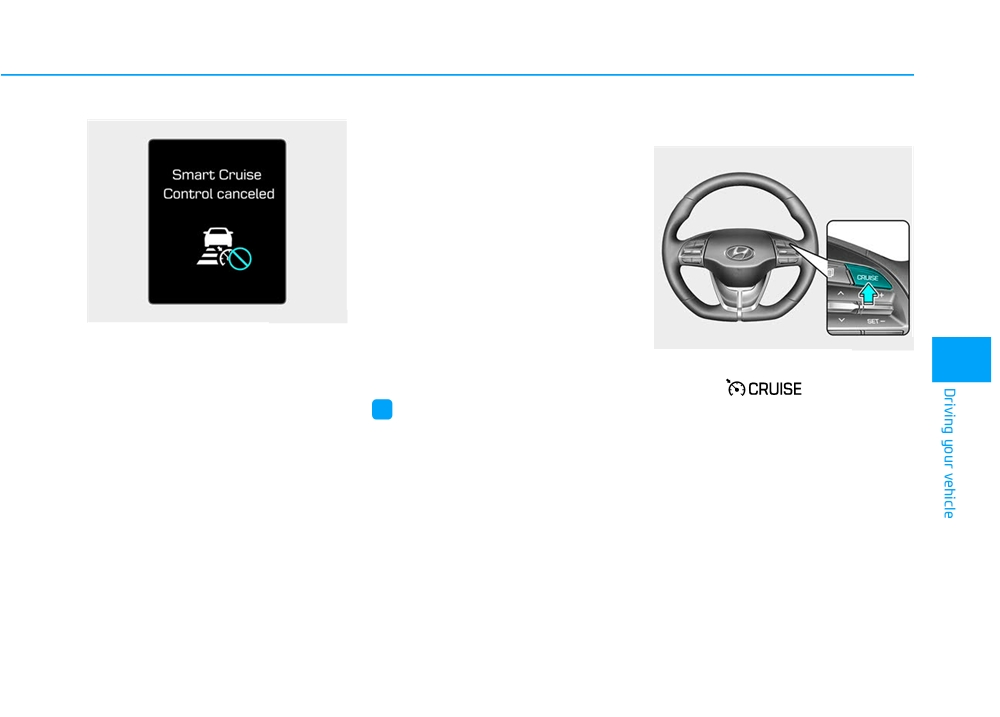
To resume Smart Cruise Control
To turn Cruise Control off
set speed
If any method other than the cruise
toggle switch was used to cancel
cruising speed and the system is still
activated, the cruising speed will
automatically resume when you
push the toggle switch up (RES+) or
down (SET-).
If you push the toggle switch up
(RES+), the speed will resume to the
OAEE056165N
recently set speed. However, if vehi-
Smart Cruise Control canceled
cle speed drops below 20 mph (30
OAE056068
km/h), it will resume when there is a
If the system is cancelled, the warn-
5
vehicle in front of your vehicle.
•
Press the CRUISE button
(the
ing chime will sound and a message
will appear for a few seconds.
cruise (
) indicator light
i
Information
will go off).
You must adjust the vehicle speed by
depressing the accelerator or brake
Always check the road conditions
pedal according to the road condition
when you push the toggle switch up
ahead and driving condition.
(RES+) to resume speed.
Always check the road conditions.
Do not rely on the warning chime.
5-83

Driving your vehicle
Smart Cruise Control Vehicle-
Each time the button is pressed, the
When the lane ahead is clear:
to-Vehicle Distance
vehicle to vehicle distance changes
as follows:
To set Vehicle-to-Vehicle
Distance
Distance 4
Distance 3
Distance 2
Distance 1
For example, if you drive at 56 mph
(90 km/h), the distance is maintained
as follows:
Distance 4 - approximately 172 feet
OAE056177N
Distance 3 - approximately 130 feet
The vehicle speed will maintain the
Distance 2 - approximately 106 feet
set speed.
OAE056076
Distance 1 - approximately 82 feet
When the Smart Cruise Control
System is ON, you can set and main-
i
Information
tain the distance from the vehicle
The distance is set to the last set dis-
ahead of you without pressing the
tance when the system is used for the
accelerator or brake pedal.
first time after the vehicle is in the
ready (
) mode.
5-84

When there is a vehicle ahead
WARNING
(Continued)
of you in your lane:
• Even if the warning chime is
not activated, always pay
attention to the driving condi-
tions to prevent dangerous
situations from occurring.
• Playing the vehicle audio sys-
Distance 4
Distance 3
tem at high volume may offset
the system warning sounds.
OAEE056140R
Distance 2
Distance 1
When using the Smart Cruise
5
OAE056184N/OAE056183N/
Control System:
OAE056186N/OAE056185N
• The warning chime sounds
•
Your vehicle speed will slow down
and the Vehicle-to Vehicle
or speed up to maintain the select-
Distance indicator blinks if
ed distance.
the vehicle is unable to main-
•
If the vehicle ahead speeds up,
tain the selected distance
your vehicle will travel at a steady
from the vehicle ahead.
cruising speed after accelerating to
• If the warning chime sounds,
the set speed.
depress the brake pedal or
use the steering wheel to
actively adjust the vehicle
speed, and the distance to the
vehicle ahead.
(Continued)
5-85
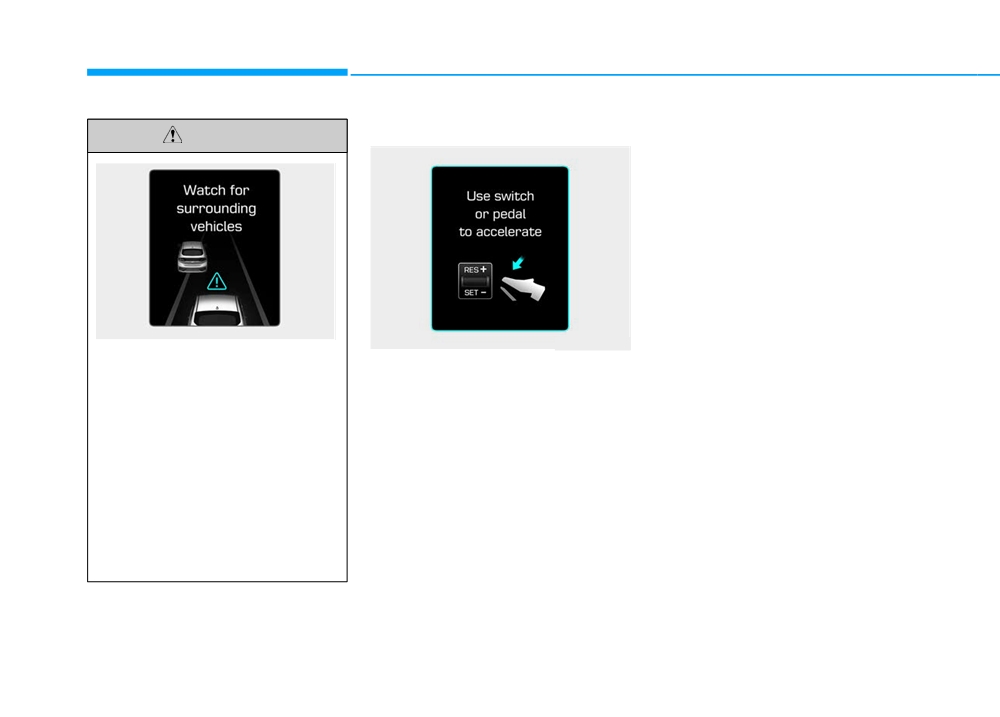
Driving your vehicle
In traffic situation
• If you push the smart cruise control
CAUTION
toggle switch (RES+ or SET-) while
Auto Hold and smart cruise control
is operating the Auto Hold will be
released regardless of accelerator
pedal operation and the vehicle will
start to move. The AUTO HOLD
indicator changes from green to
white.
OAE056168L
OAEE046473L
If the vehicle ahead
(vehicle
Use switch or pedal to accelerate
speed: less than
20 mph
(30km/h)) disappears to the next
• In traffic, your vehicle will stop if the
vehicle ahead of you stops. Also, if
lane, the warning chime will
sound and a message "Watch
the vehicle ahead of you starts
moving, your vehicle will start as
for surrounding vehicles" will
appear. Adjust your vehicle
well. However, if the vehicle stops
for more than 3 seconds, you must
speed for vehicles or objects
that can suddenly appear in
depress the accelerator pedal or
push up the toggle switch
(RES+)
front of you by depressing the
brake pedal.
to start driving.
Always pay attention to the road
condition ahead.
5-86

Sensor to detect distance to
Warning message
i
Information
the vehicle ahead
For the SCC operation is temporarily
stopped if the radar is blocked, but
you wish to use cruise control mode
(speed control function), you must
convert to the cruise control mode
(refer to "To convert to Cruise
Control mode" in the following page.
CAUTION
•
Do not apply license plate
OAEE058260L
frame or foreign objects such
OAEE056011N
5
Smart Cruise Control disabled.
as a bumper sticker or a
The Smart Cruise Control uses a
Radar blocked
bumper guard near the radar
sensor to detect distance to the vehi-
When the sensor lens cover is
sensor. Doing so may adverse-
cle ahead.
blocked with dirt, snow, or debris, the
ly affect the sensing perform-
Smart Cruise Control System opera-
ance of the radar.
tion may stop temporarily. If this
•
Always keep the radar sensor
occurs, a warning message will
and lens cover clean and free
appear on the LCD display. Remove
of dirt and debris.
any dirt, snow, or debris and clean
•
Use only a soft cloth to wash
the radar sensor lens cover before
the vehicle. Do not spray pres-
operating the Smart Cruise Control
surized water directly on the
System. The Smart Cruise Control
sensor or sensor cover.
system may not properly activate, if
(Continued)
the radar is totally contaminated, or if
any substance is not detected after
the vehicle is in the ready (
) mode
(e.g. in an open terrain).
5-87
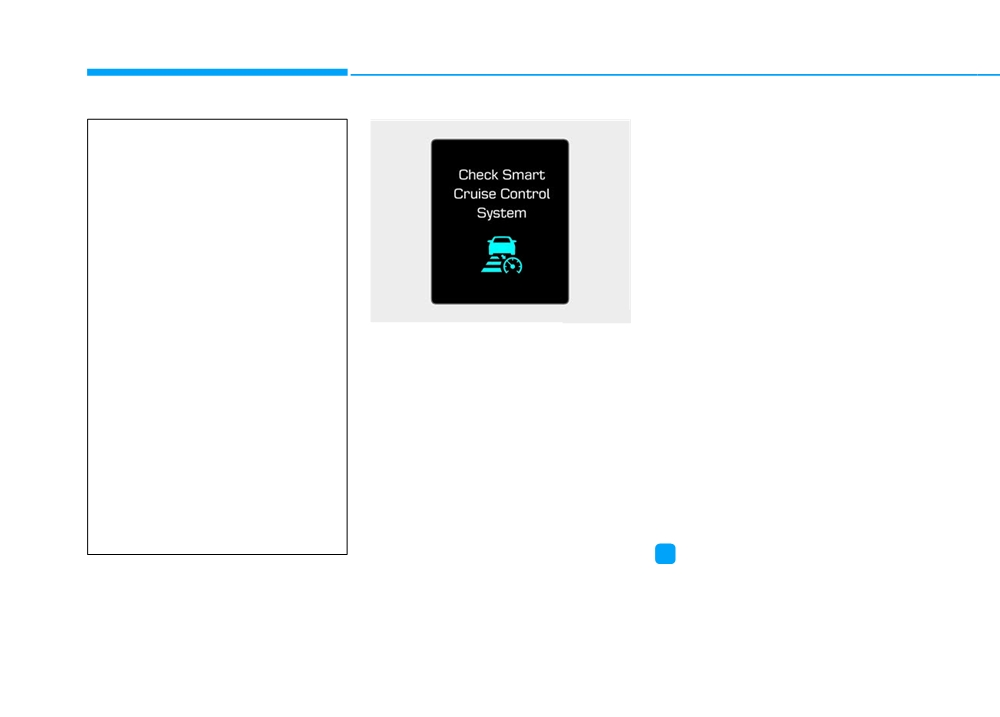
Driving your vehicle
To adjust the sensitivity of
(Continued)
Smart Cruise Control
•
Be careful not to apply unnec-
The sensitivity of vehicle speed
essary force on the radar sen-
when following the front vehicle to
sor or sensor cover. If the sen-
maintain the set distance can be
sor is forcibly moved out of
adjusted. Go to the 'User Settings →
proper alignment, the Smart
Driving Assist
→ Smart Cruise
Cruise Control System may
Control Speed → Slow/Normal/Fast'
not operate correctly. In this
on the LCD display. You may select
case, a warning message may
one of the three stages you prefer.
not be displayed. Have the
vehicle inspected by an
- Slow:
OAE056167L
authorized HYUNDAI dealer.
Vehicle speed following the front
Check Smart Cruise Control System
•
If the front bumper becomes
vehicle to maintain the set distance
damaged in the area around
The message will appear when the
is slower than normal speed.
the radar sensor, the Smart
vehicle to vehicle distance control
- Normal:
Cruise Control System may
system is not functioning normally.
Vehicle speed following the front
not operate properly. Have the
Take your vehicle to an authorized
vehicle to maintain the set distance
vehicle inspected by an
HYUNDAI dealer and have the sys-
is normal.
authorized HYUNDAI dealer.
tem checked.
- Fast:
•
Use only genuine HYUNDAI
parts to repair or replace a
Vehicle speed following the front
damaged sensor or sensor
vehicle to maintain the set distance
cover. Do not apply paint to
is faster than normal speed.
the sensor cover.
i
Information
The last selected speed sensitivity of
the smart cruise control is remained in
the system.
5-88
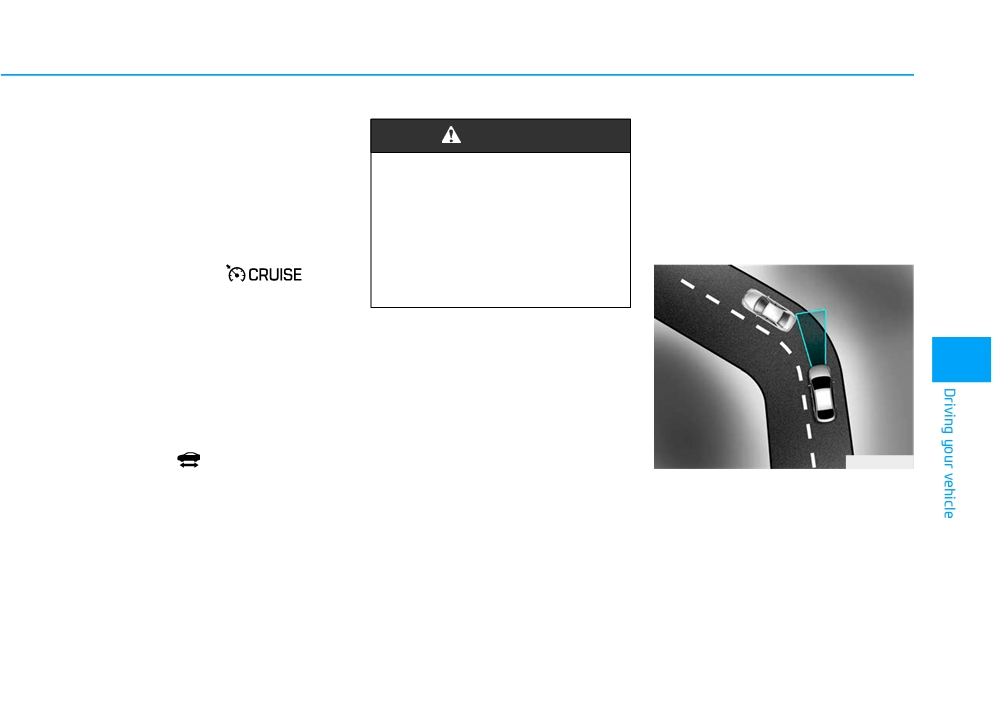
To convert to Cruise Control
Limitations of the system
WARNING
mode
The Smart Cruise Control System
The driver may choose to switch to
may have limits to its ability to detect
When using the conventional
use the conventional Cruise Control
Cruise Control mode, you must
distance to the vehicle ahead due to
mode (speed only control function)
road and traffic conditions.
manually adjust the distance to
by following these steps:
other vehicles by depressing
1. Push the CRUISE button on the
the accelerator or brake pedal.
On curves
steering wheel to turn the system
The system does not automati-
on. The cruise (
) indi-
cally adjust the distance to
cator will illuminate.
vehicles in front of you.
2. Push and hold the Vehicle-to-
Vehicle Distance button for more
than 2 seconds.
5
3. Choose between "Smart Cruise
Control" and "Cruise Control".
When the system is cancelled using
the CRUISE button or the CRUISE
button is used after the vehicle is in
the ready (
) mode, the Smart
OAE056100
Cruise Control mode will turn on.
•
The Smart Cruise Control System
may not detect a moving vehicle in
your lane, and then your vehicle
could accelerate to the set speed.
Also, the vehicle speed will
decrease when the vehicle ahead
is recognized suddenly.
•
Select the appropriate set speed
on curves and apply the brakes or
accelerator pedal if necessary.
5-89
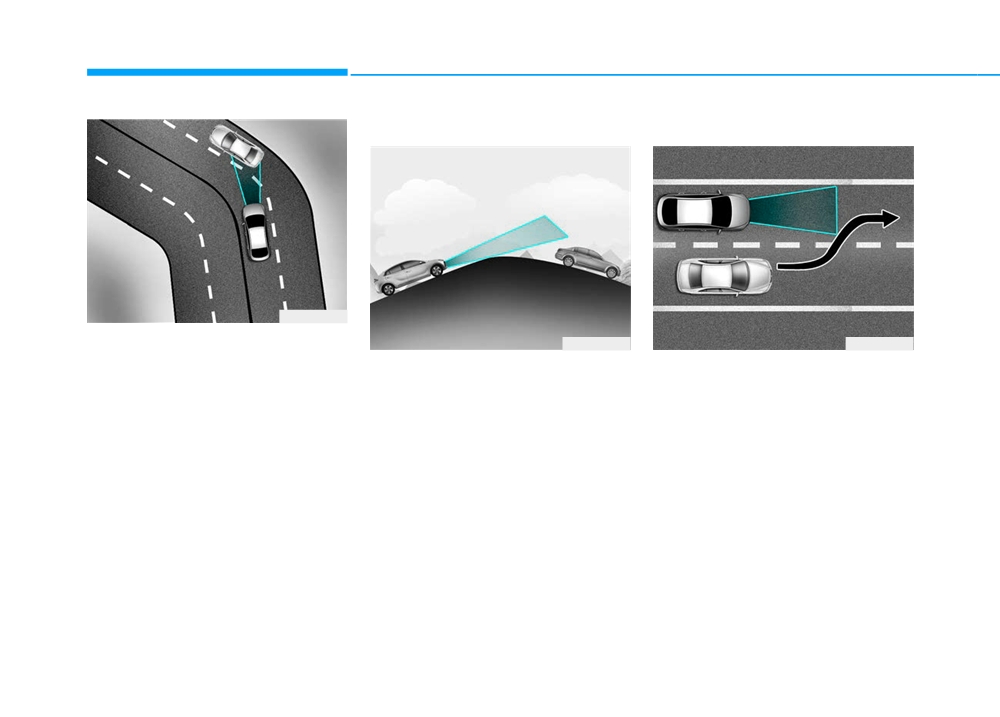
Driving your vehicle
On inclines
Lane changing
OAE056101
Your vehicle speed can be reduced
OAE056102
OAE056103
due to a vehicle in the adjacent lane.
•
During uphill or downhill driving,
•
A vehicle which moves into your
Apply the accelerator pedal and
the Smart Cruise Control System
lane from an adjacent lane cannot
select the appropriate set speed.
may not detect a moving vehicle in
be recognized by the sensor until it
Check to be sure that the road con-
your lane, and cause your vehicle
is in the sensor's detection range.
ditions permit safe operation of the
to accelerate to the set speed.
•
The radar may not detect immedi-
Smart Cruise Control.
Also, the vehicle speed will rapidly
ately when a vehicle cuts in sud-
decrease when the vehicle ahead
denly. Always pay attention to the
is recognized suddenly.
traffic, road and driving conditions.
•
Select the appropriate set speed
•
If a slower vehicle moves into your
on inclines and apply the brake or
lane, your speed may decrease to
accelerator pedal if necessary.
maintain the distance to the vehicle
ahead.
•
If a faster vehicle which moves into
your lane, your vehicle will acceler-
ate to the set speed.
5-90

Vehicle recognition
A vehicle ahead cannot be recog-
nized correctly by the sensor if any of
following occurs:
- When the vehicle is pointing
upwards due to overloading in the
luggage compartment
- While the steering wheel is operat-
ing
- When driving to one side of the
lane
- When driving on narrow lanes or
OAE056108
on curves
•
Your vehicle may accelerate when
OAE056104
Apply the brake or accelerator pedal
a vehicle ahead of you disappears.
5
Some vehicles in your lane cannot
if necessary.
•
When you are warned that the
be recognized by the sensor:
vehicle ahead of you is not detect-
- Narrow vehicles such as motorcy-
ed, drive with caution.
cles or bicycles
- Vehicles offset to one side
- Slow-moving vehicles or sudden-
decelerating vehicles
- Stopped vehicles
- Vehicles with small rear profile
such as trailers with no loads
5-91
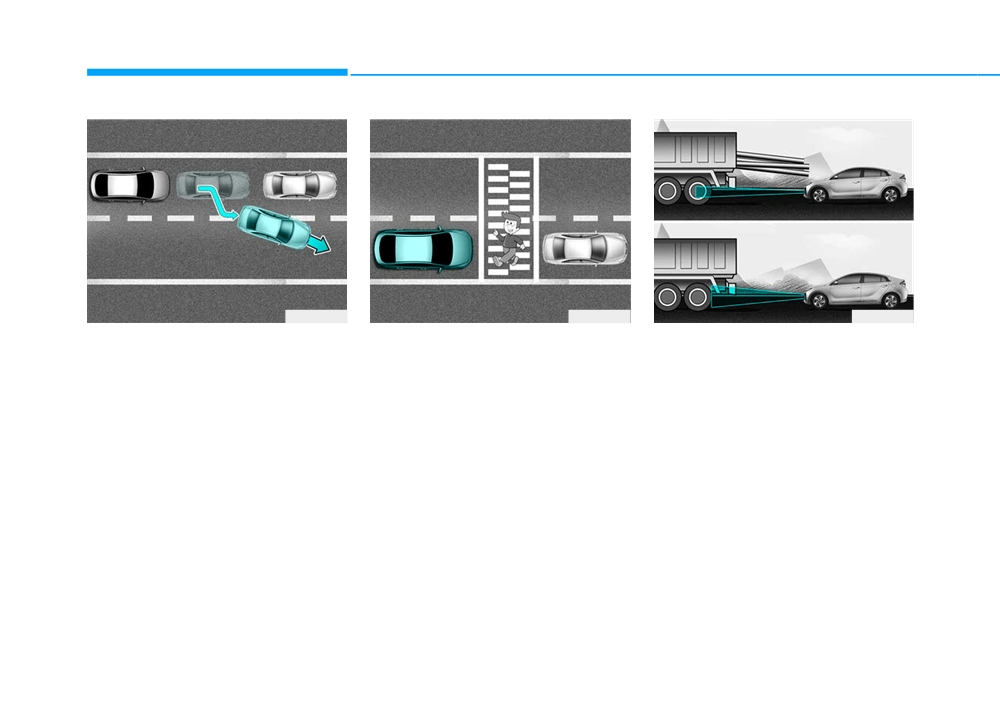
Driving your vehicle
OAE056109
OAE056110
OAE056105
• When driving in stop-and-go traffic,
• Always look out for pedestrians
• Always be cautious for vehicles
and a stopped vehicle in front of
when your vehicle is maintaining a
with higher height or vehicles car-
you merges out of the lane, the
distance with the vehicle ahead.
rying loads that sticks out from the
system may not immediately
back of the vehicle.
detect the new vehicle that is now
in front of you. In this case, you
must maintain a safe braking dis-
tance, and if necessary, depress
the brake pedal to reduce your
driving speed in order to maintain a
safe distance.
5-92
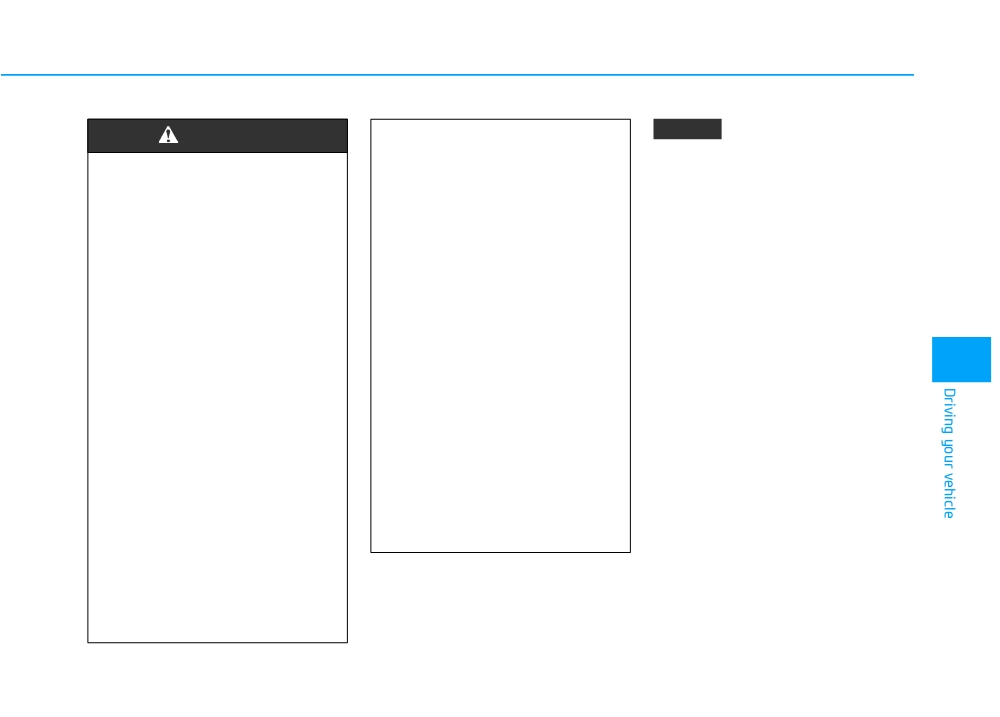
NOTICE
WARNING
(Continued)
•
Vehicles moving in front of
The Smart Cruise Control System
When using the Smart Cruise
you with a frequent lane
may not operate temporarily due
Control take the following pre-
change may cause a delay in
to:
cautions:
the system's reaction or may
•
Electrical interference
•
If an emergency stop is nec-
cause the system to react to a
•
Modifying the suspension
essary, you must apply the
vehicle actually in an adjacent
•
Differences of tire abrasion or
brakes. The vehicle cannot be
lane. Always drive cautiously
stopped at every emergency
to prevent unexpected and
tire pressure
situation by using the Smart
sudden situations from occur-
•
Installing different type of tires
Cruise Control System.
ring.
•
Keep a safe distance accord-
•
Always be aware of the select-
ing to road conditions and
ed speed and vehicle to vehi-
vehicle speed. If the vehicle to
cle distance. The driver
5
vehicle distance is too close
should not solely rely on the
during a high-speed driving, a
system but always pay atten-
serious collision may result.
tion to driving conditions and
•
Always maintain sufficient
control your vehicle speed.
braking distance and deceler-
•
The Smart Cruise Control
ate your vehicle by applying
System may not recognize
the brakes if necessary.
complex driving situations so
•
The Smart Cruise Control
always pay attention to driv-
System cannot recognize a
ing conditions and control
stopped vehicle, pedestrians or
your vehicle speed.
an oncoming vehicle. Always
look ahead cautiously to pre-
vent unexpected and sudden
situations from occurring.
(Continued)
5-93
Driving your vehicle
i
Information
i
Information
This device complies with Part 15 of
Radio frequency radiation exposure
the FCC rules.
information:
Operation is subject to the following
This equipment complies with FCC
three conditions:
radiation exposure limits set forth for
an uncontrolled environment.
1. This device may not cause harmful
interference, and
This equipment should be installed
and operated with minimum distance
2. This device must accept any inter-
ference received, including interfer-
of 8 in. (20 cm) between the radiator
(antenna) and your body.
ence that may cause undesired
operation.
This transmitter must not be co-locat-
ed or operating in conjunction with
3. Changes or modifications not
any other antenna or transmitter.
expressly approved by the party
responsible for compliance could
void the user's authority to operate
the device.
5-94
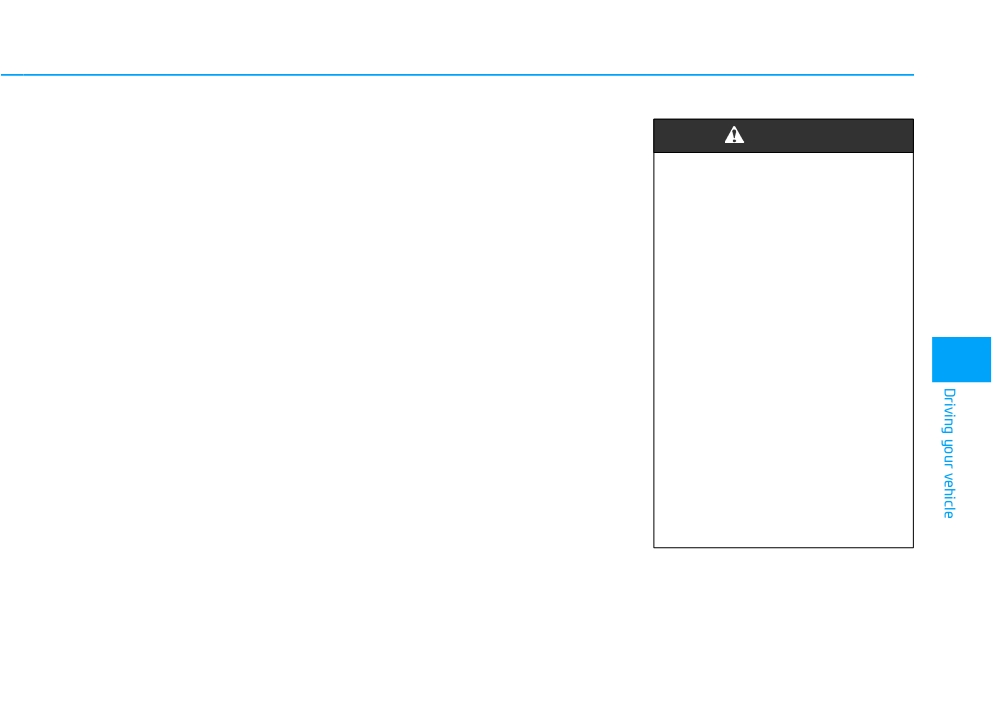
SPECIAL DRIVING CONDITIONS
Hazardous Driving Conditions
Rocking the Vehicle
WARNING
When hazardous driving elements
If it is necessary to rock the vehicle
are encountered such as water,
to free it from snow, sand, or mud,
If the vehicle is stuck and
snow, ice, mud and sand, take the
first turn the steering wheel right and
excessive wheel spin occurs,
bellow suggestions:
left to clear the area around your
the temperature in the tires can
•
Drive cautiously and keep a longer
front wheels. Then, shift back and
increase very quickly. If the tires
forth between R (Reverse) and a for-
braking distance.
become damaged, a tire blow
ward gear.
out or tire explosion can occur.
•
Avoid abrupt braking or steering.
Try to avoid spinning the wheels, and
This condition is dangerous -
•
When your vehicle is stuck in snow,
do not race the vehicle.
you and others may be injured.
mud, or sand, use second gear.
Do not attempt this procedure if
To prevent reduction gear wear, wait
Accelerate slowly to avoid unnec-
people or objects are anywhere
essary wheel spin.
until the wheels stop spinning before
near the vehicle.
shifting gears. Release the accelera-
•
Put sand, rock salt, tire chains or
tor pedal while shifting, and press
If you attempt to free the vehi-
5
other non-slip materials under the
lightly on the accelerator pedal while
cle, the vehicle can overheat
wheels to provide additional trac-
the reduction gear is in gear. Slowly
quickly, possibly causing an
tion while the vehicle becomes
spinning the wheels in forward and
motor compartment fire or
stuck in ice, snow, or mud.
reverse directions causes a rocking
other damage. Try to avoid spin-
motion that may free the vehicle.
ning the wheels as much as
possible to prevent overheating
of either the tires or the vehicle.
DO NOT allow the vehicle to
spin the wheels above 56 km/h
(35 mph).
5-95

Driving your vehicle
Smooth Cornering
Driving in the Rain
i
Information
Avoid braking or gear changing in
Rain and wet roads can make driving
The ESC system (if equipped) must be
corners, especially when roads are
dangerous. Here are a few things to
turned OFF before rocking the vehi-
wet. Ideally, corners should always
consider when driving in the rain or
cle.
be taken under gentle acceleration.
on slick pavement:
NOTICE
•
Slow down and allow extra follow-
ing distance. A heavy rainfall
Driving at Night
If you are still stuck after rocking
makes it harder to see and increas-
the vehicle a few times, have the
Night driving presents more hazards
es the distance needed to stop
vehicle pulled out by a tow vehicle
than driving in the daylight. Here are
your vehicle.
to avoid vehicle overheating, pos-
some important tips to remember:
•
Turn OFF your Cruise Control. (if
sible damage to the reduction
•
Slow down and keep more dis-
equipped)
gear and tire damage.
See
tance between you and other vehi-
•
Replace your windshield wiper
"Towing" in chapter 6.
cles, as it may be more difficult to
blades when they show signs of
see at night, especially in areas
streaking or missing areas on the
where there may not be any street
windshield.
lights.
•
Be sure your tires have enough
•
Adjust your mirrors to reduce the
tread. If your tires do not have
glare from other driver's head-
enough tread, making a quick stop
lamps.
on wet pavement can cause a skid
•
Keep your headlamps clean and
and possibly lead to an accident.
properly aimed. Dirty or improperly
See "Tire Tread" in chapter 7.
aimed headlamps will make it
•
Turn on your headlamps to make it
much more difficult to see at night.
easier for others to see you.
•
Avoid staring directly at the head-
•
Driving too fast through large pud-
lamps of oncoming vehicles. You
dles can affect your brakes. If you
could be temporarily blinded, and it
must go through puddles, try to
will take several seconds for your
drive through them slowly.
eyes to readjust to the darkness.
5-96

• If you believe your brakes may be
Driving in Flooded Areas
Highway Driving
wet, apply them lightly while driv-
Avoid driving through flooded areas
Tires
ing until normal braking operation
unless you are sure the water is no
returns.
Adjust the tire inflation, as specified.
higher than the bottom of the wheel
Under-inflation may overheat or
hub. Drive through any water slowly.
damage the tires.
Hydroplaning
Allow adequate stopping distance
Do not install worn-out or damaged
because brake performance may be
If the road is wet enough and you are
tires, which may reduce traction or
reduced.
going fast enough, your vehicle may
fail the braking operation.
have little or no contact with the road
After driving through water, dry the
surface and actually ride on the
brakes by gently applying them sev-
i
Information
water. The best advice is SLOW
eral times while the vehicle is moving
DOWN when the road is wet.
slowly.
Never over-inflate your tires above the
maximum inflation pressure, as speci-
The risk of hydroplaning increas-
fied on your tires.
5
es as the depth of tire tread
decreases, refer to "Tire Tread" in
Coolant and high voltage bat-
chapter 7.
tery
Be sure to check both the coolant
level and the high voltage battery
level before driving.
5-97
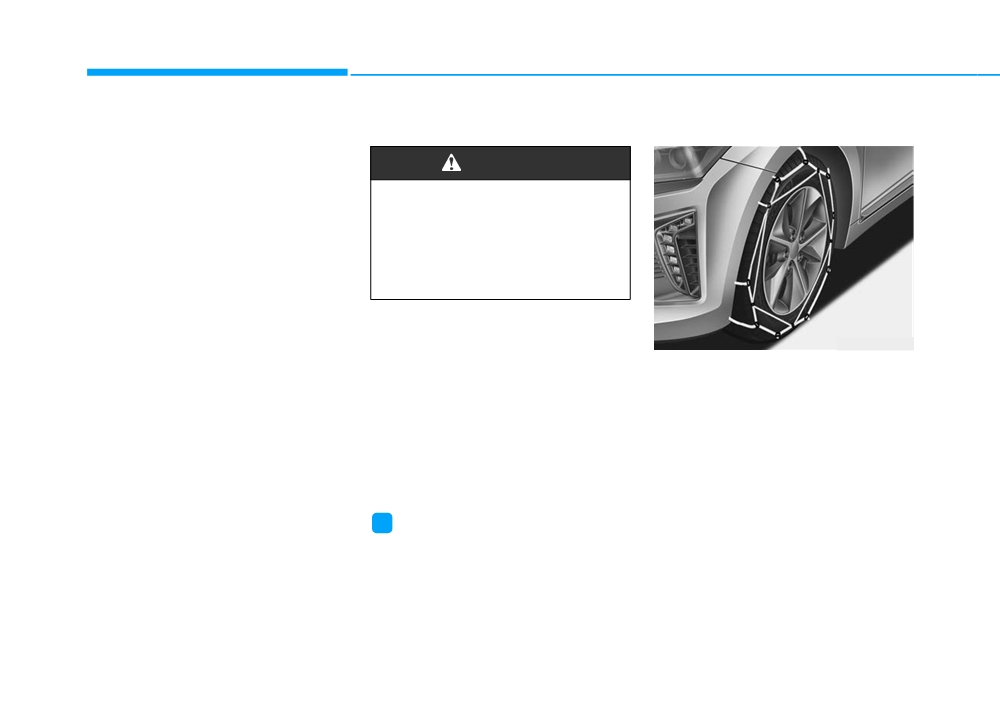
Driving your vehicle
WINTER DRIVING
The severe weather conditions of
Snow tires
Tire chains
winter quickly wear out tires and
cause other problems. To minimize
WARNING
winter driving problems, you should
take the following suggestions:
Snow tires should be equivalent
in size and type to the vehicle's
standard tires. Otherwise, the
Snow or Icy Conditions
safety and handling of your
You need to keep sufficient distance
vehicle may be adversely affect-
between your vehicle and the vehicle
ed.
in front of you.
Apply the brakes gently. Speeding,
If you mount snow tires on your vehi-
rapid acceleration, sudden brake
cle, make sure to use radial tires of
OAEE056015
applications, and sharp turns are
the same size and load range as the
potentially very hazardous practices.
original tires. Mount snow tires on all
Since the sidewalls of radial tires are
During deceleration, use regenera-
four wheels to balance your vehicle’s
thinner than other types of tires, they
tive braking to the fullest extent.
handling in all weather conditions.
may be damaged by mounting some
Sudden brake applications on snowy
The traction provided by snow tires
types of tire chains on them.
or icy roads may cause the vehicle to
on dry roads may not be as high as
Therefore, the use of snow tires is
skid.
your vehicle's original equipment
recommended instead of tire chains.
To drive your vehicle in deep snow, it
tires. Check with the tire dealer for
Do not mount tire chains on vehicles
maximum speed recommendations.
equipped with aluminum wheels; if
may be necessary to use snow tires
or to install tire chains on your tires.
unavoidable use a wire type chain. If
tire chains must be used, use gen-
Always carry emergency equipment.
i
Information
uine HYUNDAI parts and install the
Some of the items you may want to
Do not install studded tires without
tire chain after reviewing the instruc-
carry include tire chains, tow straps
first checking local, state and munici-
tions provided with the tire chains.
or chains, a flashlight, emergency
pal regulations for possible restric-
Damage to your vehicle caused by
flares, sand, a shovel, jumper cables,
tions against their use.
improper tire chain use is not cov-
a window scraper, gloves, ground
ered by your vehicle manufacturer’s
cloth, coveralls, a blanket, etc.
warranty.
5-98
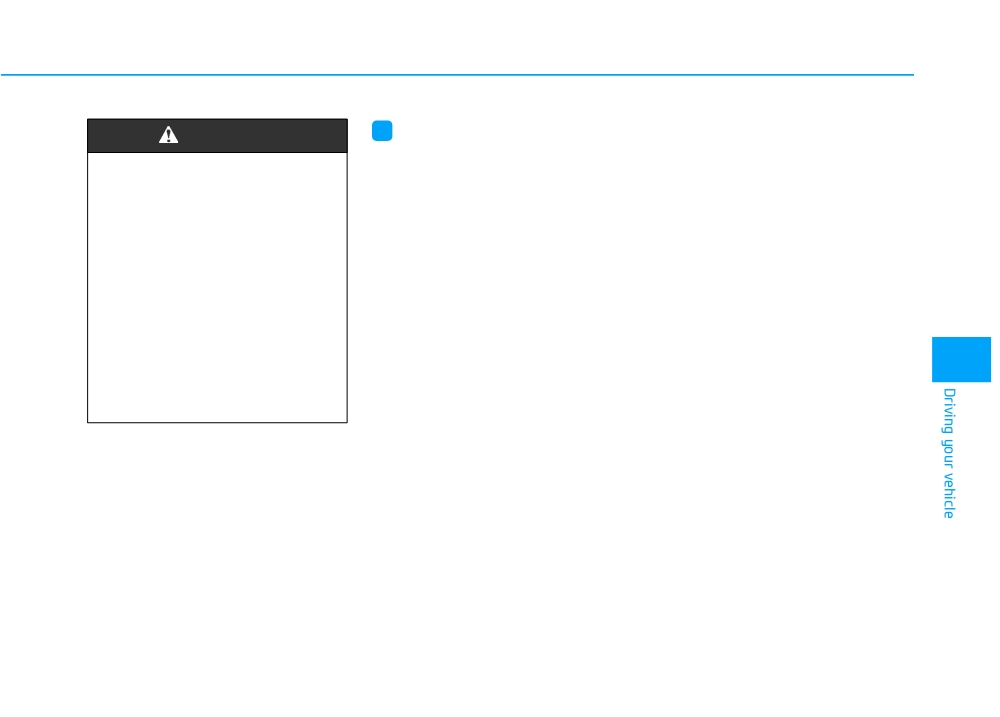
Chain Installation
i
Information
WARNING
When installing tire chains, follow the
•
Install tire chains only in pairs and
manufacturer's instructions and
The use of tire chains may
on the front tires. It should be noted
mount them as tightly possible. Drive
adversely affect vehicle han-
that installing tire chains on the
slowly (less than 20 mph (30 km/h))
dling:
tires will provide a greater driving
with chains installed. If you hear the
•
Drive less than 20 mph (30
force, but will not prevent side
chains contacting the body or chas-
km/h) or the chain manufac-
skids.
sis, stop and tighten them. If they still
turer's recommended speed
•
Do not install studded tires without
make contact, slow down until the
limit, whichever is lower.
first checking local, state and
noise stops. Remove the tire chains
•
Drive carefully and avoid
municipal regulations for possible
as soon as you begin driving on
bumps, holes, sharp turns,
restrictions against their use.
cleared roads.
and other road hazards, which
When mounting snow chains, park
may cause the vehicle to
the vehicle on level ground away
bounce.
5
from traffic. Turn on the vehicle
•
Avoid sharp turns or locked
Hazard Warning Flasher and place a
wheel braking.
triangular emergency warning device
behind the vehicle
(if available).
Always place the vehicle in P (Park),
apply the parking brake and turn off
the vehicle before installing snow
chains.
5-99
Большое спасибо!
Ваше мнение очень важно для нас.

Нет комментариевНе стесняйтесь поделиться с нами вашим ценным мнением.
Текст